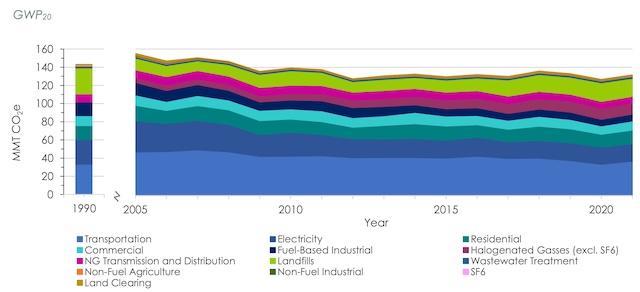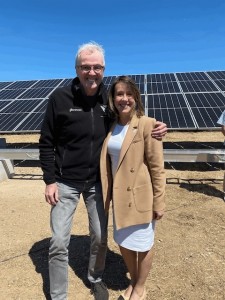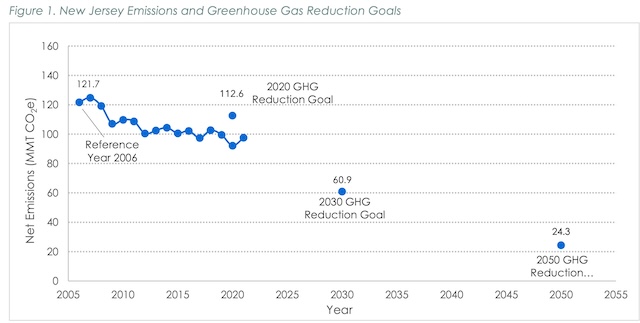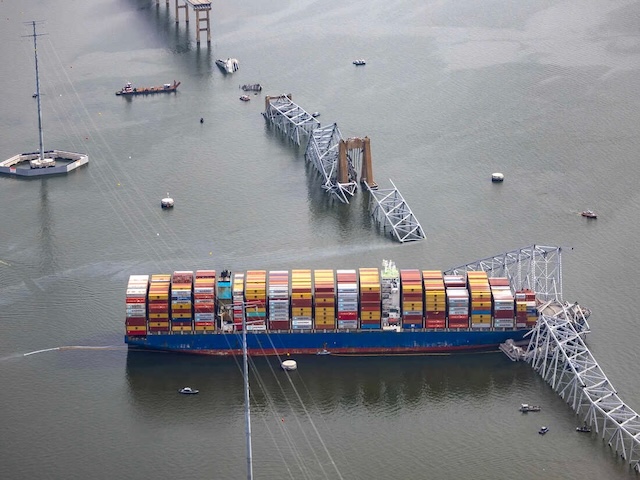NJ Has Made Little Progress In Reducing Greenhouse Gas Emissions
Small Reductions That Have Been Made Result From Closing Coal Power Plants
A Long Way To Go To Meet Emissions Reductions Goals
Gov. Murphy’s Record Is Grossly Exaggerated
DEP Commissioner LaTourette Gaslights About Emissions “Cap”

(Source: NJ DEP Greenhouse Gas Emissions Inventory (2021)
I thought I’d add a quick dose of reality to the self congratulatory efforts of NJ State officials – and their sycophantic cheerleaders and media stenographers – regarding alleged progress in reducing greenhouse gas emissions and seriously addressing the climate emergency.
The latest is Gov. Murphy’s press release on increases in solar capacity, “capping off” Earth Week, see:
And the Governor always holds these press events at old landfills – never at the farms and forests that are being destroyed by these industrial scale “solar farms”.
And the Governor downplays greenhouse gas emissions or discussion of the specifics on exactly how these renewable energy projects impact emissions and local air pollution.
(NJ has fallen sharply from a leading ranked State in solar capacity to a laggard. California gets almost 30% of electricity from solar, while NJ gets less than 4%.)

NJ Gov. Murphy gives new Sierra Club Chapter Director a hug. She has been a disaster and total cheerleader.
The policy objectives have become more about “promoting environmental justice”, union jobs, corporate subsidies, and economic development. Climate and environmental groups have more than willingly gone along with that shift in program objectives from the need for deep and rapid emissions reductions to promotion of social policy, corporate profits, and partisan politics – they have championed it.
So, for some reality, here is DEP’s most recent greenhouse gas emissions inventory.
The data in that Report are rarely presented in news reports.
The most recent report is from 2021, so it is possible that NJ emissions have actually increased, like global increases and according to EPA, US National emissions, both of which are increasing.
Above is a chart of NJ’s historic emissions – as you can see, while there has been some reduction, the emissions are fairly stable over a 32 year period (1990 – 2021).
As the DEP Report notes, the small emissions reductions that have been achieved resulted from the closing of coal power plants, but even that small reduction is exaggerated and misleading because the large lifecycle GHG emissions from natural gas are not fully considered (e.g. from the fracking wellhead, to gas transmission and distribution pipelines, compressor stations, etc).
As the DEP Report notes, emissions from the transportation sector resulting from more fuel efficient vehicles and electric vehicles have been wiped out by increases in vehicle miles traveled and sales are large gas guzzling SUV’s and trucks.
A Long Way To Go

(Source: NJ DEP Greenhouse Gas Emissions Inventory (2021)
There is a pattern of highly misleading claims made about increased capacity of renewable energy.
That renewable capacity data is almost always presented in relation to number of homes served or cars taken off the road (and note the Governor’s use of the term “expected”:)
New Jersey’s Solar for All award is anticipated to deliver approximately 175 megawatts of solar energy to benefit 22,000 low-income households within the first five years of funding, resulting in approximately $250 million in total energy bill savings over 30 years for residents in newly connected households. Additionally, the award is expected to result in CO2 emission reductions of 240,000 short tons and enable 90 megawatt-hours of energy storage associated with multi-family housing.
The false inference that is drawn from these juxtapositions is that one unit of renewable energy replaces one unit of fossil energy. That is not true. That this solar power will be directly distributed to nearby low income homes. That is not true either. Nor will this solar capacity have any impact on local air pollution.
Rarely if ever are claims made about the actual impact on local in state emissions (GHG and other air pollutants).
Rarely if ever are data presented on actual GHG emissions, fossil energy imports, and growth in energy demand, which offset and even eliminate any “expected” emissions reductions from the renewable capacity.
There is confusion about a reduction in the rate of GROWTH, versus real reduction in emissions.
In addition to that, there is the concept of “net emissions”, which allow all sorts of schemes – like offsets, trading, biofuels, carbon capture, etc – that are not real emissions reductions and may not even reduce net emissions.
As the DEP Report documents, actual emissions reductions that have been achieved are related to the shut down of coal power plants. There is a message in that reality:
The only way to reduce greenhouse gas emissions is to stop the extraction of fossil fuels and the construction of fossil infrastructure, and rapidly phase out existing fossil infrastructure, along with huge changes in lifestyle, consumption, and the entire corporate capitalist economic growth paradigm.
And on that front – although NJ is not a fossil fuels producing state – we do have refineries and gas pipelines and power plants and they are GROWING in capacity and emissions, not being shut down.
As an example of that, watch Murphy DEP Commissioner LaTourette dissemble when asked if he will stop issuing permits to new fossil gas power plants and pipeline infrastructure (direct question posed at time 1:45).
At time 5;25, he gaslighted again about the proposed Passaic Valley Sewage Commission gas power plant. (see also:
And in the course of that gaslighting and dissembling, LaTourette even lied by claiming that he had established a “cap” on emissions (at time 6:45).
I assume he was referring to the Governor rejoining the Regional Greenhouse Gas Initiative (RGGI) – but if so, he left out the fact that that is an emissions allowance trading program, not a true “cap”.
The DEP’s flawed CO2 power plant rule does not establish a cap and instead is based on emission rates.
So, the next time these claims are made, please ask tough questions and look at the data.



